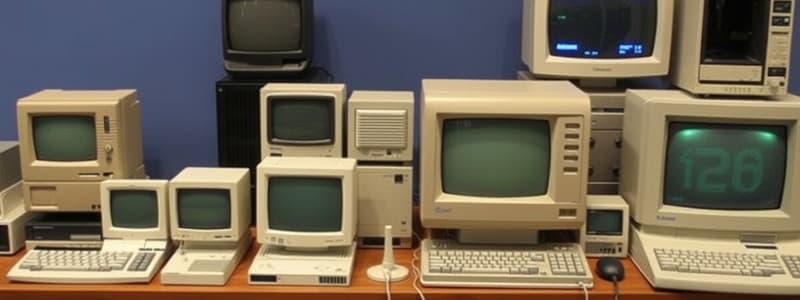Podcast
Questions and Answers
What was a primary limitation of first generation computers?
What was a primary limitation of first generation computers?
- They used high-level programming languages.
- They could perform multiple tasks simultaneously.
- They relied on advanced operating systems.
- They could only solve one problem at a time. (correct)
What replaced vacuum tubes in second generation computers?
What replaced vacuum tubes in second generation computers?
- Magnetic tapes
- Integrated circuits
- Punched cards
- Transistors (correct)
Which feature was introduced in the second generation of computers?
Which feature was introduced in the second generation of computers?
- Storage of instructions in memory (correct)
- Reliance on printouts for output
- Use of punched cards for input
- Higher electricity use
What technology marked the hallmark of third generation computers?
What technology marked the hallmark of third generation computers?
Which programming method did first generation computers utilize?
Which programming method did first generation computers utilize?
What was a major drawback of transistors in the second generation computers?
What was a major drawback of transistors in the second generation computers?
Which of the following statements is true about the second generation of computers?
Which of the following statements is true about the second generation of computers?
How did output display change from first to second generation computers?
How did output display change from first to second generation computers?
What characterized the first generation of computers?
What characterized the first generation of computers?
Which computer is recognized as the first commercially available computer?
Which computer is recognized as the first commercially available computer?
Which generation of computers began to use integrated circuits?
Which generation of computers began to use integrated circuits?
What does EDVAC stand for?
What does EDVAC stand for?
What significant feature did the EDVAC introduce?
What significant feature did the EDVAC introduce?
When was the Osborne 1 released?
When was the Osborne 1 released?
Who designed the first stored program computer, EDVAC?
Who designed the first stored program computer, EDVAC?
How many generations of computers are recognized in the provided content?
How many generations of computers are recognized in the provided content?
What significant advancement did transistors contribute to the development of computers?
What significant advancement did transistors contribute to the development of computers?
Which characteristic best defines the computers of the third generation?
Which characteristic best defines the computers of the third generation?
What was a major feature of fourth generation computers?
What was a major feature of fourth generation computers?
What distinguishes the fifth generation of computers?
What distinguishes the fifth generation of computers?
How did integrated circuits improve upon second generation computers?
How did integrated circuits improve upon second generation computers?
What role did the operating system play in third generation computers?
What role did the operating system play in third generation computers?
What are some features that emerged in fourth generation computers?
What are some features that emerged in fourth generation computers?
Which technology is still being perfected in the fifth generation of computers?
Which technology is still being perfected in the fifth generation of computers?
Flashcards are hidden until you start studying
Study Notes
History of Computers
- Five generations of computers span from 1946 to today, each marked by significant technological advancements.
First Generation (1946-1958)
- Utilized vacuum tubes for circuitry and magnetic drums for memory.
- Operated using machine language, solving one problem at a time.
- Input methods included punched cards and paper tape; output displayed on printouts.
- Large physical size, often occupying entire rooms.
Second Generation (1959-1964)
- Transistors replaced vacuum tubes, improving size, speed, reliability, and energy efficiency.
- One transistor could replace 40 vacuum tubes, although heat generation remained a concern.
- Transitioned to assembly language for programming, moving away from cryptic binary.
- Stored instructions in memory using magnetic core technology.
- Still relied on punched cards for input and printouts for output.
Third Generation (1965-1970)
- Marked by the development of integrated circuits that combined multiple transistors onto a single chip.
- Enabled user interaction through keyboards and monitors, supported by operating systems.
- Operating systems allowed simultaneous execution of multiple applications.
- Computers became smaller and more affordable, reaching a broader audience.
Fourth Generation (1971-present)
- Introduction of microprocessors, integrating thousands of circuits into one chip.
- Capable of networking, leading to the development of the Internet.
- Emergence of graphical user interfaces (GUIs), mice, and handheld devices.
Fifth Generation (Present and Future)
- Focused on Artificial Intelligence (AI) development, incorporating parallel processing and superconductors.
- Emphasis on natural language processing and devices capable of learning and self-organization.
- Existing applications include voice recognition technology.
Notable Computers and Innovations
- ENIAC: Considered one of the earliest computers; developed by Eckert and Mauchly.
- UNIVAC I: First commercial computer, designed by Eckert and Mauchly.
- EDVAC: The first stored program computer, designed by Von Neumann in 1952, capable of holding both program and data.
- Osborne 1: The first portable computer, released in 1981.
Pioneers in Computing
- Electronic Controls Company: Founded by Eckert and Mauchly in 1949, recognized as the first computer company.
Studying That Suits You
Use AI to generate personalized quizzes and flashcards to suit your learning preferences.




